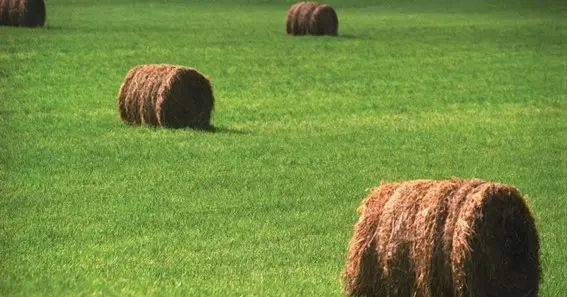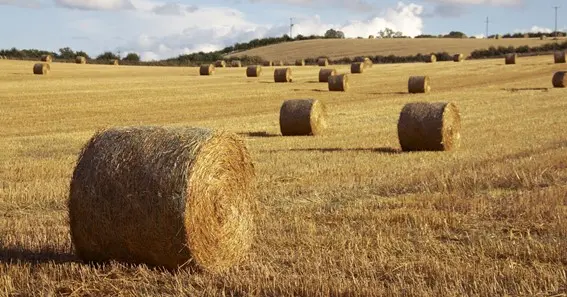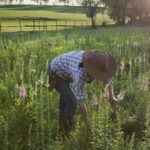What is hay? Hay is dried plant material used as animal feed to provide essential nutrients and fiber. Many animals, including pets, eat hay daily. This adaptable feed provides healthy nutrients to animals. Hay, dried plant material, is stable, long-lasting sustenance for plant-eaters. It would help if you learned about hay, its types, its nutritional value, and how to store and select it to appreciate its importance. In this article, we discuss about what is hay and more about it.
What Is Hay?
Hay is dried plant material used as animal feed to provide essential nutrients and fiber. Herbivores, including cows, horses, rabbits, and guinea pigs, need it. Unlike specialist animal meals, hay can include many plants with various health benefits.
Haymaking involves cutting plants at their most nutritious stage. The clipped plants are left in the yard to dry until they get enough water. Bales dry hay. This drying procedure preserves plant matter as nourishment for months. Hay has diverse nutritional profiles because the plants used to make it vary.
Things You Ought to Understand About Hay

Understanding what is hay helps ensure it fits animal nutritional needs. Know the types, their nutritional worth, how to store them, and how to choose them to keep animals healthy. This section covers everything you need to know about animal hay selection.
Types of Hay
Different types of hay benefit other animals and uses. The primary types are grass and legume hay.
- Grass hay: These include timothy hay, orchard grass, and fescue. Compared to bean hays, grass hays have more fiber and less protein. They are ideal for older animals and those that need a high-fiber, low-protein diet.
- Legume Hay: Common examples include alfalfa and clover. Legume hays provide more protein and calcium than other hays, making them beneficial for growing animals, protein-deficient animals, and pregnant or nursing animals. However, they are healthful. Therefore, adult animals shouldn’t overeat to avoid fat and health issues.
Health Benefits of Hay
The type of plant, harvest time, and drying method affect hay’s nutritional content. Hay is high in fiber, which aids digestion. Here we discuss what is hay benefits:
- Fiber Quantity: Fiber helps prevent constipation, maintain stomach health, and improve gut health. It maintains regular bowel movements and digestive health.
- Protein and B vitamins: Hay protein content varies by type. Protein levels in grass hay are lower than in legume hay. Hay contains minerals and vitamins. However, improper storage or quality might reduce its content.
Growing and processing crops
The first step in creating hay is picking the plants at the correct time. Timing is crucial to hay’s nutritional value.
- Cutting: Cut plants when they’re most nutritious. Plants start to lose nutrients at full development, generally before they seed.
- To dry: Leave the cut plants on the field to dry. It may take many days, depending on the weather. Proper drying prevents mold and nutrient loss.
- Tieing: Grouped and crushed plants produce bales after drying. Depending on storage and handling, bales might be little square, enormous round, or anything different.
Storing hay

Properly storing hay prevents mold growth and nutrient loss.
- The spot: Store hay in a dry, well-ventilated area to avoid moisture buildup. It’s better to have an airy barn or shed.
- Stay safe: Hay on high platforms or tarps can stay dry in the weather and on wet ground. The appropriate approach to storing hay should keep bugs and pathogens out.
- Checking out: Examine stored hay for mold and other symptoms of decay. Avoid feeding animals moldy or soggy hay, which can make them sick.
Variety of Animal Hay
Various animals have various nutritional needs; therefore, choosing the correct hay is crucial.
- Equine: Most horses like grass hay because it contains enough fiber and protein. Alfalfa hay can provide extra nutrition to your horse.
- Cows: Dairy and beef cattle benefit from grass and bean hay for nutrition and production.
- Rats and mice: High-fiber hay like timothy or field hay helps rabbits, guinea pigs, and hamsters’ digestive processes and prevents obesity.
Healthful hay
Hay offers health benefits beyond feeding animals:
- Healthy Digestion: Hay’s fiber content aids digestion and prevents digestive issues. It reduces colic and other gastrointestinal problems and promotes regular urination.
- Oral Health: Hay helps herbivores avoid tooth overgrowth and its issues by wearing down their teeth faster.
- Mental stimulation: Foraging and eating hay can assist companion animals stay entertained and active.
Common Hay issues
Despite its benefits, here is a discussion of what is hay issues:
- Mold: Moldy hay causes breathing and gastrointestinal issues and is unhealthy. Correct storage and handling reduce this risk.
- Dust: Unstable animals can have problems breathing after eating dusty hay. Store hay correctly and let it air out before giving it to reduce dust.
- Deficient nutrients: Bad hay may need more nutrition. Checking hay often and buying from excellent sources will help your animals obtain enough nutrients.
Environmental Impact of Hay Production
Haymaking can harm the environment, but eco-friendly practices can reduce it.
- Crop rotation: Crop rotation reduces chemical fertilizers and maintains soil health.
- Water Usage: Use less water and stop soil erosion with good water management.
- Maintaining land: Good land management preserves natural resources and hay production.
Conclusion
Many pets and domestic animals eat hay because it contains nutrients and is healthy. Knowing the many types of hay, how to store them, and their nutritional value is crucial for animal health. Caregivers may feed their animals the best by purchasing high-quality hay and addressing issues. This helps animals eat, grow, and stay healthy. In the above we discuss what is hay and explore more about it.
FAQ
People create hay from what plants?
Familiar hay sources are Timothy, orchardgrass, fescue, alfalfa, and clover.
How to keep hay without spoiling?
Store hay in a dry, well-ventilated, pest-free area to prevent mold and nutrient degradation.
Can hay improve animal health?
Hay helps plant-eaters digest food, maintain teeth, and avoid boredom and stress.
What are good hay indicators?
Good hay is green, fresh-smelling, and velvety. Avoid dark, moldy, or musty hay.
Why does fiber matter in hay?
Herbivores need lots of fiber to digest their meal.
What Animals Eat Hay?
Hay is a staple for animals like horses, cows, sheep, goats, and rabbits. Some smaller animals, such as guinea pigs, also benefit from hay.
Check out this insightful post aziza-kibibi-father
Sources:
https://www.britannica.com/topic/hay-animal-feed
https://study.com/academy/lesson/hay-types-baling-farming.html










